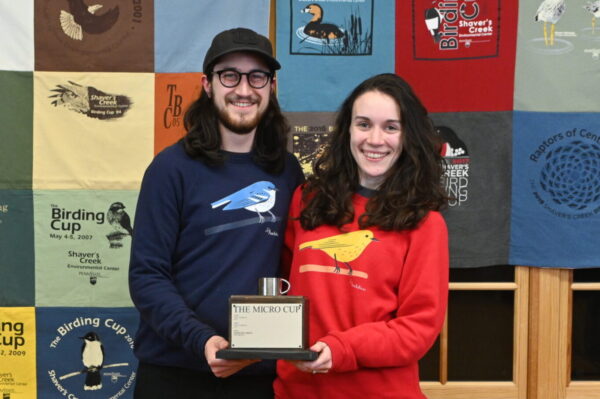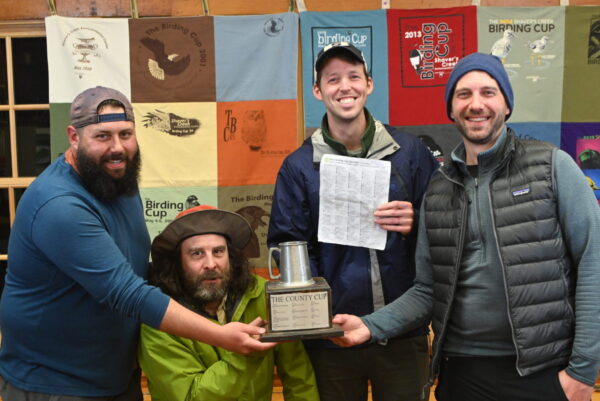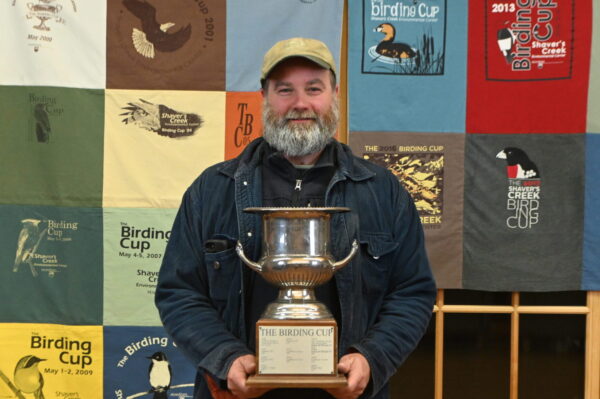Find all the teams, individual birders, and support raised at the 2022 Birding Cup Hub.
Thanks for Birding With Us!
Last year, we reintroduced three competitive Birding Cup categories while virtually welcoming birders from around the globe during a time of physical distancing. We were thrilled by our community’s positive response to the ways the Birding Cup adapted to global events. This year, we proudly reintroduced ALL of our friendly competitive categories and once again welcomed our Global Community as a non-competitive, collaborative approach to birding that welcomes birders of all skill sets from anywhere in the world, including those who are brand new to birding!
Seeing birders celebrate biodiversity in central Pennsylvania and across the globe has been nothing short of heartwarming. Despite near-constant rain in the Centre Region on May 6–7, our intrepid birders came together — raincoats and all — to bring awareness to the natural world and to support conservation. We are so thankful for our generous and joyful Shaver’s Creek community.
A great Birding Cup from Nairobi, Kenya! Being almost on the equator means only about 12 hours of sunlight year-round, so I was a bit disadvantaged against the long days the US. Nonetheless, I hit 25 species within 200 yards from home before breakfast. I went on to finish my day with 38 species, adding the Eastern Paradise-Whydah to my life list. Looking forward to next year!

The Results
Including all local and global categories, the 2022 Birding Cup saw 30 teams consisting of 109 birders count 235 unique species across the United States and Kenya. Whether these individuals were celebrating over two decades of participation, or were picking up binoculars for the first time, everyone birded and fundraised together over the same 24 hours!

Locally, teams could once again choose to compete in our five Cup categories: the Birding Cup, awarded to the team of three or more that sees the most species within seven Central Pennsylvania counties; the County Cup, to the team that sees the most species within one of those seven counties; the Birding Boot, awarded to the team that identifies the most species while traveling only by nonmotorized means; the Potter Mug, for most species seen by a team composed of members with less than two years of birding experience; and the Micro Cup, awarded to the 2-person team with the highest count within a mile-diameter circle.
Left to right: Nathan Goldner and Gabrielle Stewart Goldner
The Micro Cup went to the intrepid Honey Nut Vireos with 54 species. These two birders returned to the competition for the second year in a row, and they are now the third-ever team to win the Micro Cup. Great job!
Left to right: Jacob Sholtis, Kyra Monsam, Nick Smith, and Logan Clancy
The Potter Mug went to the fearless Flirty Flamingos, a team of recent SEED semester students, with a count of 37 species, securing the first Birding Cup trophy for any of its birders. Keep on birding, Flirty Flamingos!
Left to right: John Carter, Brian Schmoke, and Sean Herrmann
It was a very close competition, but the Feathered Body Inspectors won the Birding Boot by identifying 93 species while traveling via nonmotorized means. Congratulations, Feathered Body Inspectors!
Left to right: Matt Schenck, Paul Bartell, Will Malan, and Paul Brigman
Raiders of the Lost Lark won the County Cup with an impressive 120 species. All in one county, too! Incredible job, Raiders of the Lost Lark.
Jon Kauffman (Not pictured: John David Byler, Daniel Peachey, Titus Peachey, and Christopher Yoder)
With an astounding 132 species, the winners of the Birding Cup are the Mifflin County Mockingbirds. A glorious victory, Mifflin County Mockingbirds!
It was an insane amount of precipitation, but we kept a positive outlook and had a blast. We tallied 93 bird species, with highlights of a Mourning Warbler, a White-Eyed Vireo, and White-Winged Scoters. We collected lifelong birding memories and look forward to our next bird outing!

Why We Bird
This year, we raised funds to invest in the newly named Klingsberg Aviary. Final touches to the aviary — such as native landscaping, visitor seating, accessible pathways, educational program space, and visual screening for the comfort of smaller raptors — will improve the experience for visitors and the animals that call it home. Already a site already enjoyed by tens of thousands of annual visitors and renowned in the animal care field, these modifications will further expand the Klingsberg Aviary’s reputation as a national model.
So far, we have raised nearly $11,000. Thank you for your support! The bird counting may be over (for now), but if you haven’t donated, or if you were waiting to make a gift per bird, you can do so today.
This year’s Birding Cup was also made possible with the incredible support of local businesses. Shaver’s Creek would like to thank:
- Appalachian Outdoors
- Bobby Rahal Honda
- Collegiate Pride
- Lost Creek Optics
- Purple Lizard Maps
- The State College Bird Club
- The Weather Vein
- Wiscoy for Animals

The big day was cloudy with rain, but our spirits remained bright and sunny. A Bad Optics first: one good Tern deserves another (and another). We recorded Forster’s, Common, and Caspian Terns on the same day for the first time in team history!
What We Saw
Check out all 235 species below. Are some birds listed that you’ve never seen before? Thank our friends from across the globe!
- African Golden-Weaver
- African Jacana
- African Pied Wagtail
- African Sacred Ibis
- American Bittern
- American Black Duck
- American Crow
- American Goldfinch
- American Kestrel
- American Pipit
- American Redstart
- American Robin
- American Wigeon
- American Woodcock
- Baglafecht Weaver
- Bald Eagle
- Baltimore Oriole
- Bank Swallow
- Barn Owl
- Barn Swallow
- Barred Owl
- Bay-breasted Warbler
- Belted Kingfisher
- Black Kite
- Black Sawwing
- Black Tern
- Black Vulture
- Black-and-white Warbler
- Black-backed Puffback
- Black-billed Cuckoo
- Black-capped Chickadee
- Black-throated Blue Warbler
- Black-throated Green Warbler
- Blackburnian Warbler
- Blackpoll Warbler
- Blue Jay
- Blue-gray Gnatcatcher
- Blue-headed Vireo
- Blue-winged Teal
- Blue-winged Warbler
- Boat-tailed Grackle
- Bobolink
- Bonaparte’s Gull
- Broad-winged Hawk
- Bronze Mannikin
- Bronze Sunbird
- Brown Creeper
- Brown Thrasher
- Brown-headed Cowbird
- Brown-headed Nuthatch
- Bufflehead
- Canada Goose
- Canada Warbler
- Cape May Warbler
- Cape Robin-Chat
- Carolina Chickadee
- Carolina Wren
- Caspian Tern
- Cedar Waxwing
- Cerulean Warbler
- Chestnut-sided Warbler
- Chimney Swift
- Chipping Sparrow
- Cinnamon-chested Bee-eater
- Clapper Rail
- Cliff Swallow
- Collared Sunbird
- Common Bulbul
- Common Gallinule
- Common Grackle
- Common Loon
- Common Merganser
- Common Myna
- Common Raven
- Common Tern
- Common Waxbill
- Common Yellowthroat
- Cooper’s Hawk
- Dark-eyed Junco
- Double-crested Cormorant
- Downy Woodpecker
- Dunlin
- Eastern Bluebird
- Eastern Kingbird
- Eastern Meadowlark
- Eastern Paradise-Whydah
- Eastern Phoebe
- Eastern Screech-owl
- Eastern Towhee
- Eastern Whip-poor-will
- Egyptian Goose
- European Starling
- Field Sparrow
- Fish Crow
- Forster’s Tern
- Gadwall
- Golden-crowned Kinglet
- Golden-winged Warbler
- Grasshopper Sparrow
- Gray Catbird
- Gray Heron
- Great Black-backed Gull
- Great Blue Heron
- Great Crested Flycatcher
- Great Egret
- Great Horned Owl
- Greater Yellowlegs
- Green Heron
- Green-winged Teal
- Grosbeak Weaver
- Hadada Ibis
- Hairy Woodpecker
- Hermit Thrush
- Herring Gull
- Hooded Merganser
- Hooded Warbler
- Horned Grebe
- Horned Lark
- House Finch
- House Sparrow
- House Wren
- Indigo Bunting
- Java Sparrow
- Kenya Rufous Sparrow
- Killdeer
- Laughing Gull
- Least Bittern
- Least Flycatcher
- Least Sandpiper
- Lesser Scaup
- Lesser Yellowlegs
- Little Swift
- Long-tailed Cormorant
- Louisiana Waterthrush
- Magnolia Warbler
- Malachite Kingfisher
- Mallard
- Marabou Stork
- Marsh Wren
- Mississippi Kite
- Mourning Dove
- Mourning Warbler
- Mute Swan
- Nashville Warbler
- Northern Cardinal
- Northern Flicker
- Northern Harrier
- Northern Mockingbird
- Northern Parula
- Northern Rough-winged Swallow
- Northern Waterthrush
- Olive Thrush
- Orchard Oriole
- Osprey
- Ovenbird
- Painted Bunting
- Palm Warbler
- Pectoral Sandpiper
- Peregrine Falcon
- Pied Crow
- Pied-billed Grebe
- Pileated Woodpecker
- Pine Warbler
- Prairie Warbler
- Purple Finch
- Purple Martin
- Red-bellied Woodpecker
- Red-billed Firefinch
- Red-breasted Merganser
- Red-breasted Nuthatch
- Red-eyed Vireo
- Red-headed Woodpecker
- Red-knobbed Coot
- Red-rumped Swallow
- Red-shouldered Hawk
- Red-tailed Hawk
- Red-winged Blackbird
- Ring-billed Gull
- Ring-necked Dove
- Ring-necked Duck
- Ring-necked Pheasant
- Rock Pigeon
- Rose-breasted Grosbeak
- Royal Tern
- Ruby-crowned Kinglet
- Ruby-throated Hummingbird
- Ruffed Grouse
- Saffron Finch
- Savannah Sparrow
- Scaly-breasted Munia
- Scarlet Tanager
- Sharp-shinned Hawk
- Short-eared Owl
- Snowy Egret
- Solitary Sandpiper
- Song Sparrow
- Sora
- Speckled Mousebird
- Speke’s Weaver
- Spotted Sandpiper
- Swainson’s Thrush
- Swamp Sparrow
- Tree Swallow
- Tufted Titmouse
- Turkey Vulture
- Variable Sunbird
- Veery
- Vesper Sparrow
- Village Weaver
- Virginia Rail
- Warbling Vireo
- White-breasted Nuthatch
- White-browed Sparrow-Weaver
- White-crowned Sparrow
- White-eyed Slaty-Flycatcher
- White-eyed Vireo
- White-throated Sparrow
- White-winged Scoter
- Wild Turkey
- Willet
- Willow Flycatcher
- Wilson’s Snipe
- Wilson’s Warbler
- Winter Wren
- Wood Duck
- Wood Thrush
- Worm-eating Warbler
- Yellow Warbler
- Yellow-billed Cardinal
- Yellow-billed Cuckoo
- Yellow-billed Duck
- Yellow-fronted Canary
- Yellow-rumped Warbler
- Yellow-throated Vireo
- Yellow-throated Warbler

Check out the global Trip Report, which includes how many individuals of each species were seen. Please note, some species are omitted from our eBird checklists due to their conservation status or because they were not yet uploaded to eBird by the respective team.





